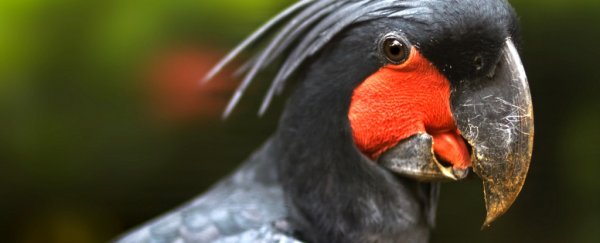Palm cockatoos don't simply warble or croon like other birds. The northern Australian birds are drummers.
These Neil Pearts of the parrot world break off sticks or seedpods and, holding the object in their feet, rap against hollow tree branches.
The knock-knock-knock of twig on wood is, to female palm cockatoos, quite studly. Drumming draws biologists to the cockatoos, too.
"Tool-use in the animal world is virtually always in the context of foraging," said Robert Heinsohn, an evolutionary ecologist who studies birds at the Australian National University.
Utensils might help an animal extract bugs from a hive or crush a tough seed. But as the only animal besides humans to use tools to drum, palm cockatoos are exceptional.
What's more, Heinsohn said, the birds "produce sequences of sound with 'musical' properties."
According a study of 18 wild palm cockatoos, published Wednesday in the journal Science Advances, the parrots tap out non-random, regularly sequenced beats. The birds, in other words, get rhythm.
Among animals, "drumming per se is fairly common," said Christopher J. Clark, a biology professor at the University of California at Riverside who was not involved in this research.
Mammals such as rodents and rabbits drum with their feet, he pointed out in an email, "though all of these are in the context of warning calls, not courtship."
Several species of birds looking for love turn to percussion. Woodpeckers hammer away with their beaks. Birds called cordon-bleus use their feet. (In fact, male blue-capped cordon-bleus "tap dance" to court mates.)
Only a few bird species use tools - and none use them in the manner of the cockatoos.
"What's unusual about these parrots is they're drumming with an instrument," Clark said, "rather than simply using part of their body."
Building tools "implies higher level cognitive processes akin to our own," Heinsohn said.
The cockatoos build nests by snapping off branches and placing them in tree hollows.
"So it was probably a small step for some bright spark to start tapping with one, and to find the sound pleasing," he said. "If the females liked it, you can see why it would take off."
Drumming may be a cockatoo family tradition.
"I have no doubt that sons would also learn the drumming techniques (making of tools and rhythmic sounds) from their fathers," Heinsohn said.
It's part of a complex ritual. They drum against the edge of the tree hollows to make the sound resonate. At the same time they whistle and screech, while bobbing their heads or raising their feathered crests. It's sort of adorable, too.
As the biologist said, "one particularly cute thing is that they 'blush' when sexually excited. They expose their red cheek patches which become much brighter."
Heinsohn and his colleagues recorded 131 instances of drumming parrots in the Australian wild.
On average, the birds tapped once every 0.8 seconds - a deliberate smack, slower than the animals are able to kick.
Statistical analysis showed the beats, per Heinsohn, "were very significantly not random at all, and instead had hardly any variation in the interval."
What's more, each of the 18 males in the new study demonstrated his own drumming style.
"Some preferred to tap more slowly on average and others more quickly," Heinsohn said. "Some would start with a faster flourish before settling into their steady rhythm."
This might allow other birds to recognize the individual that's drumming.
Rhythmic drumming is a bit of an evolutionary puzzle. Human drummers, at least the good ones, can follow a tempo. Our closest ape relatives do not.
Chimpanzees slap tree stumps "with their hands and feet as a long range signal to their group," Heinsohn said, but they do not whack the trees with a regular beat. In one laboratory study, it took scientists a year to train rhesus monkeys to tap in sync with a metronome.
Even then it seemed the monkeys were reacting to, rather than anticipating, the metronome tick.
These birds are "remarkably humanlike" in their ability to generate a rhythmic beat, Heinsohn said.
There's one notable exception to that comparison. Across human cultures, drumming is a group activity, and closely tied to things like dancing.
For these birds, drumming has explicit content: It is a mating song for an audience of one.
Male birds performed the large majority, about two-thirds, of the observed drum sessions in the presence of a female.
"Palm cockatoos show us that regular percussive rhythm can evolve as part of a solo performance by males to females," Heinsohn said.
"Although they are not closely related to us this still points to the distinct possibility that the preference for a regular beat in human societies had other origins" - such as courtship - "before being applied so joyfully to group-based music and dance."
2017 © The Washington Post
This article was originally published by The Washington Post.
